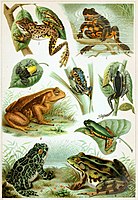
Giant Toads (Rhinella marina) From the Industrial Zones of Low Basin of the Coatzacoalcos River (Veracruz, MX) Presents Genotoxicity in Erythrocytes
Sign Up to like & getrecommendations! Published in 2021 at "Bulletin of Environmental Contamination and Toxicology"
DOI: 10.1007/s00128-021-03162-2
Abstract: The lower basin of Coatzacoalcos River is one of the most polluted regions of the southern Gulf of Mexico. Organochlorine compounds, polybrominated diphenyl ethers, polycyclic aromatic hydrocarbons, and heavy metals have been registered in this… read more here.
Keywords: coatzacoalcos river; toads rhinella; basin coatzacoalcos; genotoxicity ... See more keywords

Cane toads (Rhinella marina) rely on water access, not drought tolerance, to invade xeric Australian environments
Sign Up to like & getrecommendations! Published in 2018 at "Oecologia"
DOI: 10.1007/s00442-018-4321-1
Abstract: The invasion of habitats with novel environmental challenges may require physiological tolerances not seen in conspecifics from the native range. We used a combination of field and laboratory-based experiments to assess physiological tolerance to limited… read more here.
Keywords: water; toads rhinella; rhinella marina; water access ... See more keywords

An invasion in slow motion: the spread of invasive cane toads (Rhinella marina) into cooler climates in southern Australia
Sign Up to like & getrecommendations! Published in 2021 at "Biological Invasions"
DOI: 10.1007/s10530-021-02597-2
Abstract: Geographical variation in abiotic and biotic conditions can significantly affect the rate that an invasive species expands its range. The colonisation of Australia by cane toads (Rhinella marina) has attracted extensive research, but mostly in… read more here.
Keywords: invasion; rhinella marina; cane toads; toads rhinella ... See more keywords

Thin-skinned invaders: geographic variation in the structure of the skin among populations of cane toads (Rhinella marina)
Sign Up to like & getrecommendations! Published in 2020 at "Biological Journal of The Linnean Society"
DOI: 10.1093/biolinnean/blaa128
Abstract: The structure of the skin may evolve rapidly during a biological invasion, for two reasons. First, novel abiotic challenges such as hydric conditions may modify selection of traits (such as skin thickness) that determine rates… read more here.
Keywords: structure skin; rhinella marina; toads rhinella; skin ... See more keywords

At the invasion front, male cane toads (Rhinella marina) have smaller testes
Sign Up to like & getrecommendations! Published in 2019 at "Biology Letters"
DOI: 10.1098/rsbl.2019.0339
Abstract: As a colonizing species expands its range, individuals at the invasion front experience different evolutionary pressures than do those at the range-core. For example, low densities at the edge of the range mean that males… read more here.
Keywords: invasion front; invasion; rhinella marina; toads rhinella ... See more keywords

Is the behavioural divergence between range-core and range-edge populations of cane toads (Rhinella marina) due to evolutionary change or developmental plasticity?
Sign Up to like & getrecommendations! Published in 2017 at "Royal Society Open Science"
DOI: 10.1098/rsos.170789
Abstract: Individuals at the leading edge of expanding biological invasions often show distinctive phenotypic traits, in ways that enhance their ability to disperse rapidly and to function effectively in novel environments. Cane toads (Rhinella marina) at… read more here.
Keywords: range; toads rhinella; edge; range core ... See more keywords

No evidence for cold-adapted life-history traits in cool-climate populations of invasive cane toads (Rhinella marina)
Sign Up to like & getrecommendations! Published in 2022 at "PLoS ONE"
DOI: 10.1371/journal.pone.0266708
Abstract: As an invasive organism spreads into a novel environment, it may encounter strong selective pressures to adapt to abiotic and biotic challenges. We examined the effect of water temperature during larval life on rates of… read more here.
Keywords: cool climate; rhinella marina; life history; life ... See more keywords